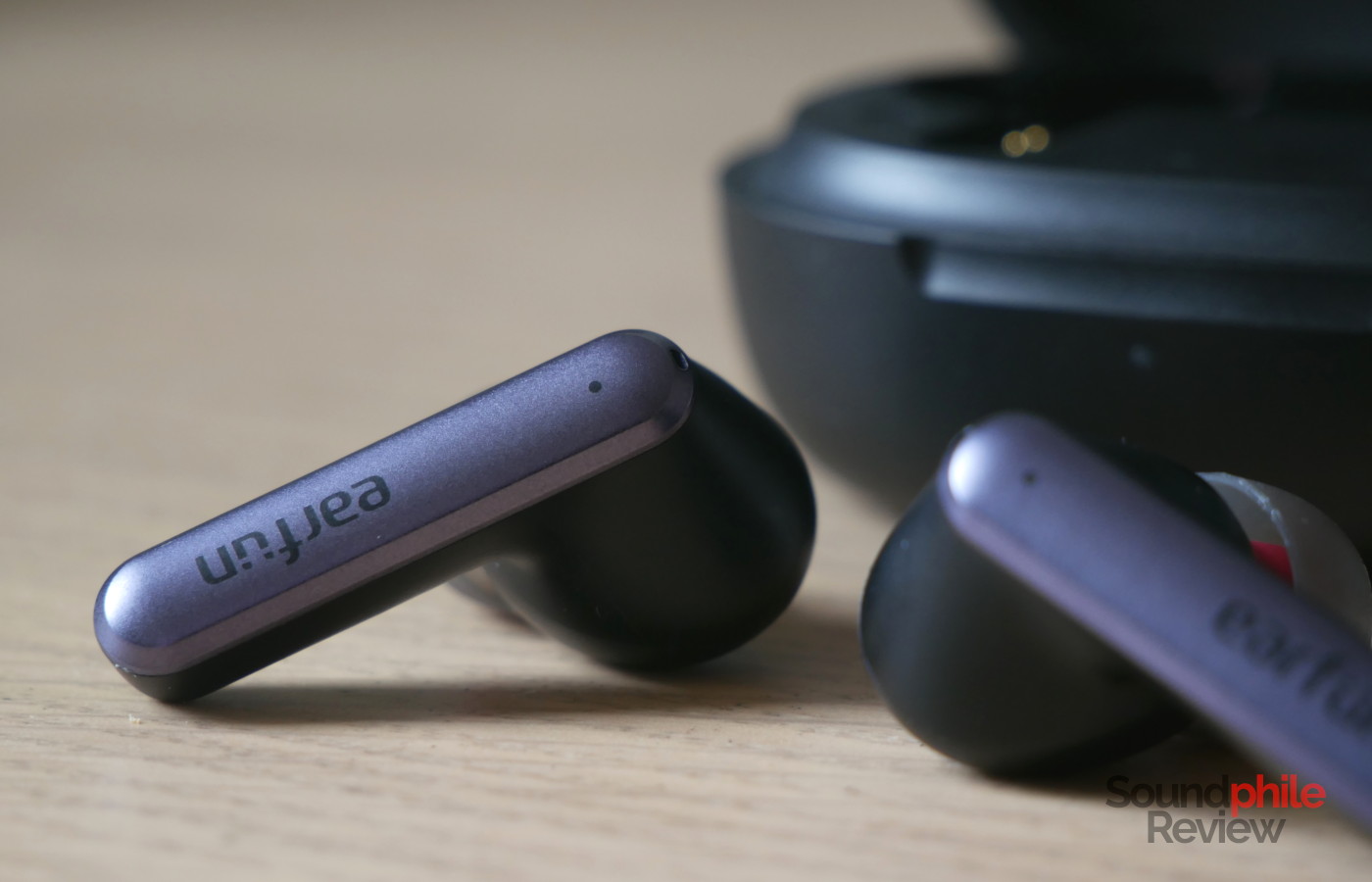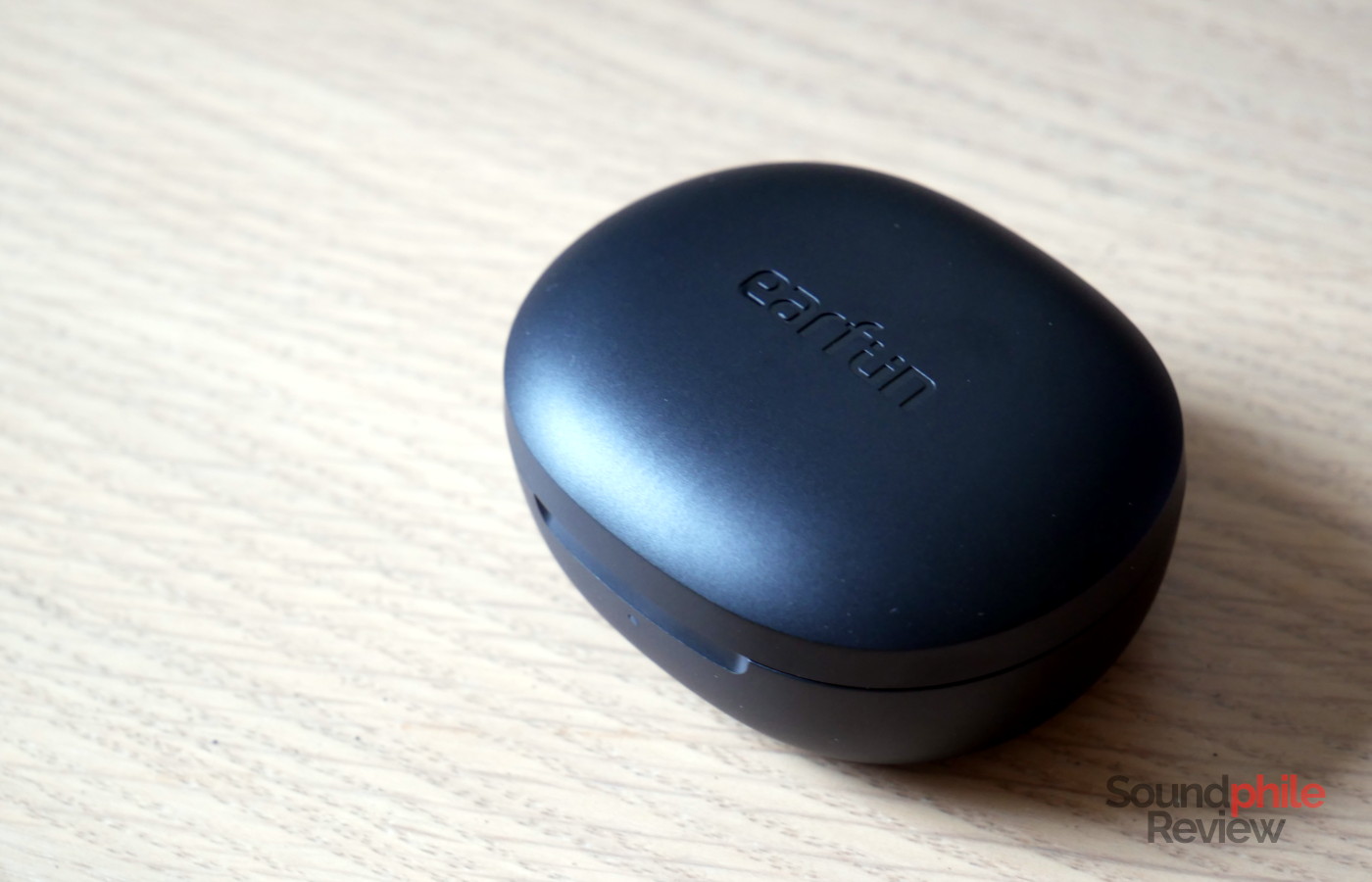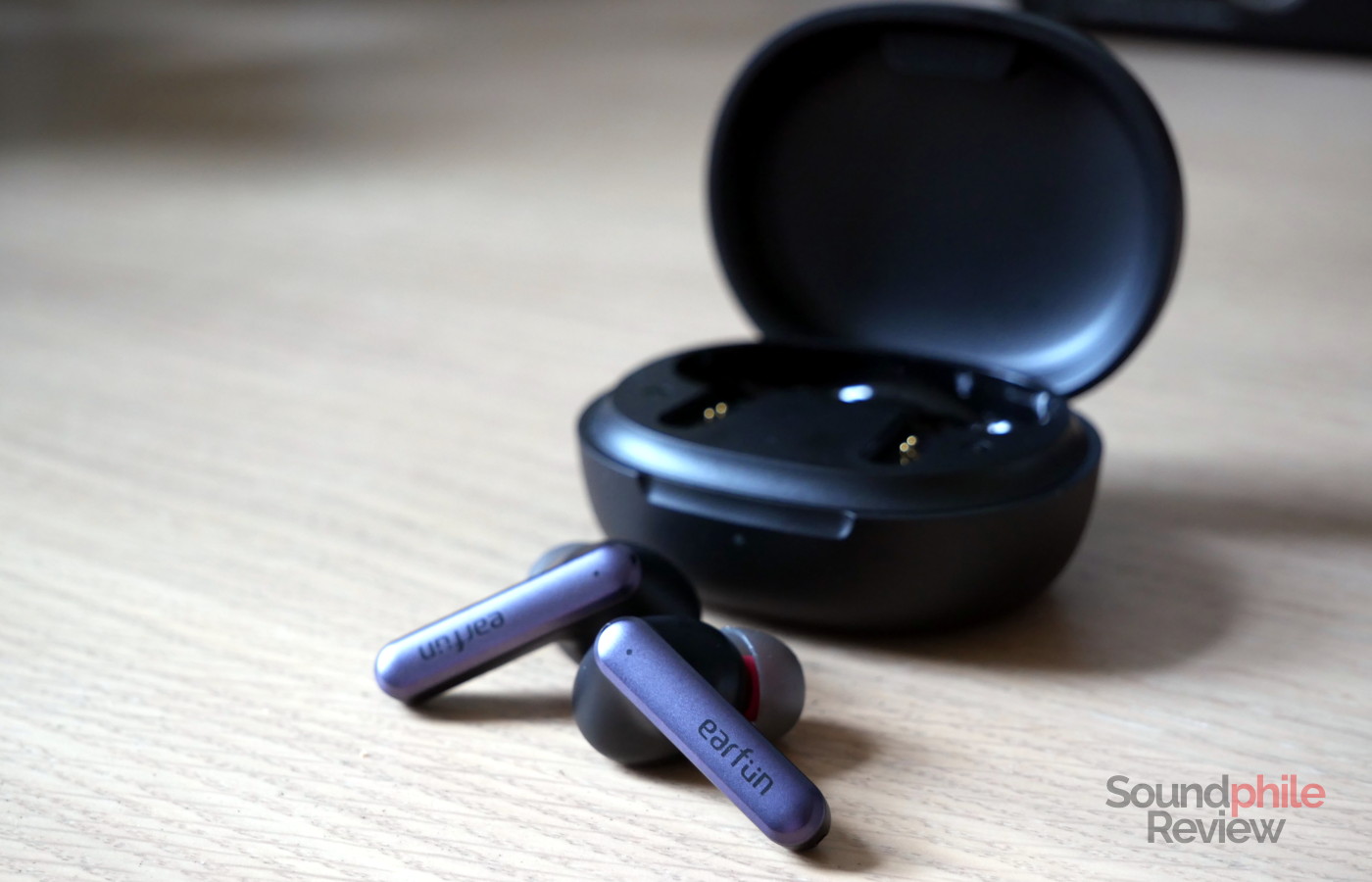The EarFun Air S are a new version of the EarFun Air, launched almost two years ago. The new model changes just about everything, beginning with the design and ending with the sound. We find a rather complete set of features that includes ANC and even a low-latency mode for viewing films or playing games. But is that – and the low price – enough?
Disclaimer: my thanks to EarFun for providing a free unit. The official price for the Air S is $69.99, but they’re hosting a promotion for the launch that brings the price down to $48.99. You can buy them from Amazon using the code EFAIRS25 to get the price down to $52.49 (25% off). The code is valid until the 15th of September.
TL;DR: recap
| Pros |
Cons |
| + Very comfortable
+ Effective noise cancelling + High-quality codecs + Good application + Equalisation is carried across devices |
– Stock tuning requires equalisation
– Short battery life |
Rating: 6.9/10
Packaging & Accessories

The cardboard box contains the earphones themselves in their charging case, a user manual, a stick with a cotton tip to clean the earphones, a USB to USB-C cable and a set of eartips in three additional sizes (for a total of four sizes, including the ones already installed on the earphones).
Design & Comfort

The EarFun Air S adopt the same basic design as many other earphones nowadays, with a stem protruding from a pill-shaped shell. The stems are at an angle compared to the nozzle or, if you prefer, the nozzle is angled so that it points downwards; this greatly helps with comfort. The shell itself, as well as half of the stem, is made of black plastic, while the exterior of the stem is coloured in dark grey. On the top section of the stem there are two holes: one is for the ambient microphone, which is used to provide the ANC feature, the other is for the status LED.

I can’t find any faults in how the EarFun Air S are built; in fact, they’re assembled quite well for being low-cost earbuds. They are IPX5 certified, which means you can use them while doing sports or in other situations where there’s high humidity or water involved.
Comfort is great, with a fit that’s neither too deep nor too shallow; I would say that it is in fact a mid-depth fit, which will probably satisfy fans of both deep and shallow insertion. The fact that the Air S use “normal” tips, instead of specialised, short tips, also probably makes them comfortable for a wider range of people.

Isolation is mild, but sufficient to drown out most noises in a quiet environment.

The case is the same EarFun already used with other products: almost oval in shape, flat and with a status LED on the front and a USB-C port on the back. It’s made of the same plastic as the earphones and looks and feels decently solid. I like that it can be opened with one hand and the lid then stays open; as it is flat, you can lay it onto a surface and it will stay there, open. It also supports wireless charging.
Extra Features & Battery Life

The EarFun Air S support the Bluetooth 5.2 standard with the SBC, AAC and aptX codecs. The connection is quite stable and the range is decent as well, as I can move around the house without many issues, even when there are multiple walls between me and the source.
The touch controls are quite well implemented; touching on the top of the stem activates them, which leaves you free to adjust the earphones in your ears as you please without inadvertently issuing commands to the earphones. There’s a full set of controls available: one tap reduces volume (left) or increases it (right); two taps play or pause music and answer or end a call (on both earpieces); a triple tap enables “game mode” (left) or skips to the next track (right); tap-and-hold cycles between ANC, ambient mode and normal mode (left) or invokes the voice assistant (right). “Game mode” lowers the latency to below 100 ms, which is still noticeable but low enough as not to have any practical effect.
Although it is a bit hampered by the relatively low passive isolation, ANC is decently effective. It can reduce an electric kettle, which normally makes quite a racket, to an absolutely bearable volume, but it does show its limits with very loud noises. This is especially true if they’re in the mid and high regions, though that’s not exclusive to the Air S, as it is more of a limitation of the technology itself. Overall, the Air S do a decent job at cancelling noises. This appears to be thanks to the Qualcomm QC3046 SoC that takes care of this.

The microphone works well in quiet environments, but struggles a bit when there’s ambient noise. Overall, though, it is good enough to handle calls while on the go.
In my experience, battery life is around 5 hours without ANC enabled, which is a bit low for today’s standards even in the affordable segment of the market. Enabling ANC takes its toll and brings the figure down to around 4 hours.
Software
EarFun provides users with the EarFun Audio application, for both Android and iOS, which allows you to customise the earphones as well as update their firmware. Through the app you can set the ANC mode, enable the game mode, access the equaliser, change the name of the device, customise controls as well as update the firmware and access various information (FAQs, product manual, etc).
While the feature set is pretty standard nowadays, the equalisation feature surprised me, as it permanently changes the sound signature of the earphones. Once you set it, you get the same equalisation on every device you connect the earbuds to, which means you can truly shape their sound to your liking. There’s not much in terms of controls, as you are just given three bands (bass, mids and treble) to fiddle with, but that’s enough for most people.
Sound & Specs
I’ve tested the EarFun Air S by pairing them with my desktop computer.
EarFun Air S |
| Frequency response | N/A |
| Impedance | N/A |
| Sensitivity | N/A |
| Bluetooth version | 5.2 |
| Codecs | SBC, AAC |
Soundstage is limited in both width and depth, and it gives you the impression of music playing in a small space. Imaging is limited in how it places instruments on the stage and offers just the basic left-centre-right positions. Instrument separation is severely hampered by the sound signature.
Bass would normally be quite emphasised, but with the preponderance of upper midrange and treble that we see with the Air S, it’s actually almost subdued. It’s in fact barely audible, even in tracks where it normally takes a central role – Zeromus by The Black Mages is a good example of that, with the bass lines at the beginning being drowned out by the cymbals. It’s decently fast and carries a good amount of detail, so it’s really a pity that it’s not more audible.
Midrange is heavily skewed towards the upper region, so far so as the lower and middle regions being heavily recessed and barely audible in comparison. A track like The Rocking Grounds by The Black Mages has the high-pitched synthesizers basically drown out everything else, with even the electric guitars left behind – and bass being barely audible. Detail is decent, but it is hampered by the sound signature.
Treble is very accentuated, with multiple peaks that make it quite prominent in the mix. In fact it is the most prominent area, which a fact which can quickly lead to fatigue. These multiple peaks make cymbals quite energetic, but the fact that they’re mostly concentrated in the middle area also means that they lack body. Detail is sufficient and in line with expectations from earphones in this price range.
As a small aside, I decided to try out the Air S while gaming to test their low-latency mode and I found that the additional oomph in the bass section, which emerges clearly when there’s little treble, provided that “wow” factor that many people are after. Monster Hunter: World definitely sounds great with these!
Final Thoughts
I’ve tried a few EarFun earphones at this point and they all have the same qualities and the same issues, the main one of the latter being the out-of-the-box tuning that privileges upper midrange and treble. The problem is not so much this privilege in and of itself, but how it is done: multiple spikes make the sound as a whole aggressive and quite fatiguing, especially if you are already sensitive to treble. The sound signature as a whole suffers from these peaks as they’re significant and end up detracting from the overall listening experience. I really hope that EarFun experiments a bit with their tuning in the future, because in terms of features and design they are able to deliver quite good value.
In fact, the ANC feature is implemented well, while the design is good-looking and comfortable. Build quality is good, too. In the end it’s all down to your personal preference, but there are better-sounding earphones out there at a similar, or even lower, price, so my suggestion would be to look at those: as an example, the QCY T13 and the UGREEN HiTune T3, while definitely not perfect, offer better sound quality out of the box. That said, the fact that the equalisation set in the app is kept across devices is certainly a big plus and makes it possible to rein in the treble, making the EarFun Air S a much better proposition that can compete with its peers. They are also great as gaming earphones, thanks to their low-latency mode and immersive sound, so they are a valid option if you want something you can game with, both on the go or with your PC or console.






